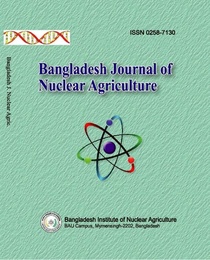PROFITABILITY AND PRODUCTIVITY OF DROUGHT TOLERANT RICE VARIETY BINADHAN-21 IN SOME SELECTED AREAS OF BANGLADESH (Short communication)
Abstract
The study was conducted in five major BINA developed Aus rice growing areas of Bangladesh, namely Mymensingh, Rangpur, Kushtia, Chapai Nawabganj and Magura district. The study focused on the profitability and productivity of Binadhan-21; and the major constraints to Binadhan-21 production. Simple random sampling technique was followed for this study. A total of 100 farmers were randomly selected as sample size in the study areas, 20 from each district. Data were collected from Aus rice growers through interview schedule. Collected data were edited, summarized, tabulated and analyzed to fulfill the objectives. Some descriptive statistics were used. Binadhan-21 production is highly profitable in the study area. The average yield was 4.86 t ha-1 in Aus season and undiscounted BCR was 1.93. Therefore, Binadhan-21 farmers received high return on its investment. The farmers in the study areas encountered some constraints to Binadhan-21 production. The first ranked was unavailability of seeds in all areas. Other constraints were lack of training (70.83%), crop lost by bird and animal (56.61%), and natural calamities (19.30%).
References
Bandumula, N. 2018. Rice Production in Asia: Key to Global Food Security. Proc. Natl. Acad. Sci. India Sect. B Biol. Sci. 88: 1323–1328. [Google Scholar] [CrossRef]
FAOSTAT. 2021. Production/Yield Quantities of Rice, Paddy in World + (Total). Food and Agriculture Organization of the United Nations, Available online: https://www.fao.org/faostat/en/#data/QCL/visualize (accessed on 1 September 2021.
Islam, S.F., de Neergaard, A., Sander, B.O., Jensen, L.S., Wassmann, R. and van Groenigen, J.W. 2020. Reducing greenhouse gas emissions and grain arsenic and lead levels without compromising yield in organically produced rice. Agriculture, Ecosystems and Environment, 295(January), 106922. https://doi.org/10.1016/j.agee.2020.106922
Kabir, M.J., Gaydon, D.S., Cramb, R., and Roth, C. 2017. ‘Bioeconomic evaluation ofcropping systems for saline coastal Bangladesh: I. Simulation under historical andfuture environments’, Submitted and in-review with Agricultural Systems.
Mackill, D.J., Ismail, A.M., Pamplona, A.M., Sanchez, D.L., Carandang, J.J. and Septiningsih, E.M. 2010. Stress tolerant rice varieties for adaptation to a changing climate. Crop Environ. Bioinforma. 7: 250–259.
Mainuddin, M. and Kirby, M. 2015. National food security of Bangladesh to 2050. Food Security. 7.
Mottaleb, K.A. and Mishra, A.K. 2016. Rice consumption and grain-type preference by household: a Bangladesh case. J. Agric. Appl. Econ. 48: 298–319,
Papademetriou, M.K. 2000. Rice Production in the Asia-Pacific Region: Issues and Perspectives. In: Papademetriou MK, Dent FJ, Herath EM (eds). Bridging the Rice Yield Gap in the Asia-Pacific Region, RAP Publication, Food and Agriculture Organization of the United Nations, Regional Office for Asia and the Pacific, Bangkok. pp.58–68.
Timsina, J., Wolf, J., Guilpart, N., van Bussel L.G.J., Grassini, P. and van Wart, J. 2018. Can Bangladesh produce enough cereals to meet future demand? Agric. Sys.; 163: 36-44. pmid: 29861535
United Nations (UN) 2014. The world population prospects, Key findings andadvance tables. Department of Economics and Social Affairs, Population division, New York, USA.
Wassmann, R., Jagadish, S.V.K., Sumfleth, K., Pathak, H., Howell, G., Ismail, A., Serraj, R., Redona, E., Singh, R.K. and Heuer, S. 2009. Regional vulnerability of climate change impacts on Asian rice production and scope for adaptation. Adv. Agron. 102: 91–133.
Zeigler, R.S. and Barclay, A. 2008. The relevance of rice. Rice. 1(1): 3–10.
Zhao, M., Lin, Y. and Chen, H. 2020. Improving nutritional quality of rice for human health. Theor. Appl. Genet. 133: 1397–1413. [Google Scholar] [CrossRef] [PubMed]
-
Download



